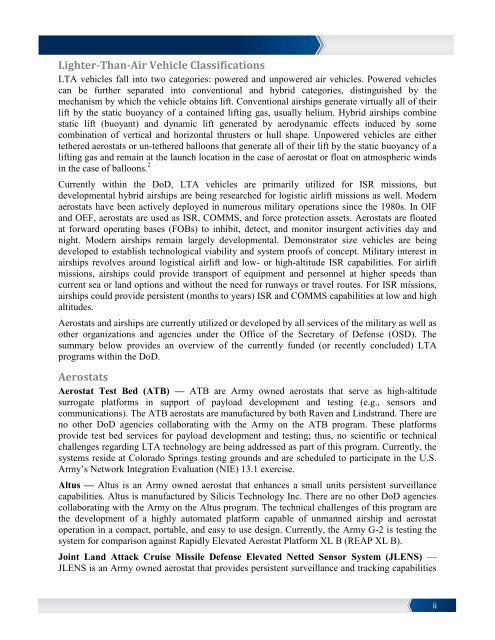lighter-than-air vehicles - Defense Innovation Marketplace
lighter-than-air vehicles - Defense Innovation Marketplace
lighter-than-air vehicles - Defense Innovation Marketplace
Create successful ePaper yourself
Turn your PDF publications into a flip-book with our unique Google optimized e-Paper software.
Lighter-Than-Air Vehicle ClassificationsLTA <strong>vehicles</strong> fall into two categories: powered and unpowered <strong>air</strong> <strong>vehicles</strong>. Powered <strong>vehicles</strong>can be further separated into conventional and hybrid categories, distinguished by themechanism by which the vehicle obtains lift. Conventional <strong>air</strong>ships generate virtually all of theirlift by the static buoyancy of a contained lifting gas, usually helium. Hybrid <strong>air</strong>ships combinestatic lift (buoyant) and dynamic lift generated by aerodynamic effects induced by somecombination of vertical and horizontal thrusters or hull shape. Unpowered <strong>vehicles</strong> are eithertethered aerostats or un-tethered balloons that generate all of their lift by the static buoyancy of alifting gas and remain at the launch location in the case of aerostat or float on atmospheric windsin the case of balloons. 2Currently within the DoD, LTA <strong>vehicles</strong> are primarily utilized for ISR missions, butdevelopmental hybrid <strong>air</strong>ships are being researched for logistic <strong>air</strong>lift missions as well. Modernaerostats have been actively deployed in numerous military operations since the 1980s. In OIFand OEF, aerostats are used as ISR, COMMS, and force protection assets. Aerostats are floatedat forward operating bases (FOBs) to inhibit, detect, and monitor insurgent activities day andnight. Modern <strong>air</strong>ships remain largely developmental. Demonstrator size <strong>vehicles</strong> are beingdeveloped to establish technological viability and system proofs of concept. Military interest in<strong>air</strong>ships revolves around logistical <strong>air</strong>lift and low- or high-altitude ISR capabilities. For <strong>air</strong>liftmissions, <strong>air</strong>ships could provide transport of equipment and personnel at higher speeds <strong>than</strong>current sea or land options and without the need for runways or travel routes. For ISR missions,<strong>air</strong>ships could provide persistent (months to years) ISR and COMMS capabilities at low and highaltitudes.Aerostats and <strong>air</strong>ships are currently utilized or developed by all services of the military as well asother organizations and agencies under the Office of the Secretary of <strong>Defense</strong> (OSD). Thesummary below provides an overview of the currently funded (or recently concluded) LTAprograms within the DoD.AerostatsAerostat Test Bed (ATB) — ATB are Army owned aerostats that serve as high-altitudesurrogate platforms in support of payload development and testing (e.g., sensors andcommunications). The ATB aerostats are manufactured by both Raven and Lindstrand. There areno other DoD agencies collaborating with the Army on the ATB program. These platformsprovide test bed services for payload development and testing; thus, no scientific or technicalchallenges regarding LTA technology are being addressed as part of this program. Currently, thesystems reside at Colorado Springs testing grounds and are scheduled to participate in the U.S.Army’s Network Integration Evaluation (NIE) 13.1 exercise.Altus — Altus is an Army owned aerostat that enhances a small units persistent surveillancecapabilities. Altus is manufactured by Silicis Technology Inc. There are no other DoD agenciescollaborating with the Army on the Altus program. The technical challenges of this program arethe development of a highly automated platform capable of unmanned <strong>air</strong>ship and aerostatoperation in a compact, portable, and easy to use design. Currently, the Army G-2 is testing thesystem for comparison against Rapidly Elevated Aerostat Platform XL B (REAP XL B).Joint Land Attack Cruise Missile <strong>Defense</strong> Elevated Netted Sensor System (JLENS) —JLENS is an Army owned aerostat that provides persistent surveillance and tracking capabilitiesii

















